We design of optical network, where Repeaterless Transmission of 112 Gb/s allows us to get 4.48 TB/s (40x100 Gb/s) over a length of 330 Standard Single Mode Fiber (SSMF-G.652), with help of DP-16-QAM (Quadrature Amplitude Modulation) and hybrid amplification technology (EDFA and RAMAN combined) to provide enough amplification, without using any special fibers, special amplifiers as like Remote Optically-Pumped Amplifiers (ROPA) or in-line amplification.
Keywords |
| DP-16-QAM; SSMF; Hybrid Amplifier |
INTRODUCTION |
| Repeaterless systems are important in undersea networks and in terrestrial spans in remote areas where inline service
access is difficult to deploy and expensive. An increase on the transmission capacity often relies on advanced
modulation formats, which are subject to stringent requirements with respect to the received optical signal-to-noise
ratio (OSNR). In this case, an upgrade in the system capacity over a legacy infra-structure is only possible if the noise
levels across the network are significantly reduced. |
| Since the large majority (over 80%) of terrestrial links is composed of SSMF ITU-T G.652 fibers, a feasible upgrade of
legacy repeaterless spans requires the use of conventional fibers and commercially available pump power sources (first
order pumps, in case of Raman amplification). For 10 Gb/s channel transmission through standard SSMF ITU-T G.652
fibers typical repeaterless spans are about 300km, when coherent detection and electrical dispersion compensation are
employed. |
| As the demand for higher data transmission goes on increasing, for such higher data rate transmission, keen design
of optical network is required to overcome the chromatic dispersion (CD), to have good Bit Error Rate (BER), and to
overcome the constraint by optoelectronic Regenerator, at the same time it should be cost effective. With all these
concerns, a system with good modulation technique with Wavelength Division Multiplexing (WDM) along with all
optical regeneration should be employed [1]. |
RELATED WORK |
| Recent investigations have reported multi-channel coherent 100 Gb/s transmission up to 462 km. However, those
transmission arrangements made use of enhanced and/or ultra large area pure silica core fiber (ITU-T G.654), or True
Wave reach fiber (ITU-T G.655.C), rather than standard single mode fibers (SSMF ITU-T G.652) [2]. Also,
sophisticated higher order amplification schemes were needed, including high order Raman amplification and remote
optically-pumped amplifiers (ROPAs), as well as erbium-ytterbium doped fiber booster amplifiers, to provide higher
output power [5]–[7]. However, when the goal is an upgrade of legacy terrestrial links from 10-40 Gb/s to 100 Gb/s
channels, those approaches may not be a feasible option. This occurs because they rely on the use of unusual optical
fibers, additional fibers to provide remote amplification, and high order Raman amplifiers, exorbitantly increasing the
overall system cost. As an alternative, we propose the use of hybrid optical amplifiers made of first-order Raman
amplifiers and erbium-doped fiber amplifiers (EDFAs), as booster and pre-amplifiers respectively, to improve the
SSMF noise performance, aiming to achieve the highest possible bandwidth-distance product for 112 Gb/s
repeaterlessfiber transmission systems. Such hybrid configurations are better because they minimize the overall OSNR
(compared to a topology using only EDFAs). We use hybrid amplification to improve OSNR, and coherent detection
for better sensitivity. The chromatic dispersion (CD) along the fiber can be compensated either by dispersion
compensation module (DCM) or electronically by Digital Signal processing method [3].All optical Regeneration is achieved by hybrid amplifiers, so that the constraints imposed by optoelectronic regenerators could be overcome and
that makes transmission of data rate higher than 40 Gb/s Possible. While concerning about the modulation techniques,
here in this experiment after a long survey of the modulation techniques, DP-16-Quadrature Amplitude Modulation
(QAM) has been chosen on considering all our requirements [8].For cost effectiveness we used Standard Single Mode
Fiber (SSMF) and Raman/EDFA Combination, without using any special amplifiers like Remote Optically- Pumped
Amplifiers (ROPA) and Special Fibers. EDFA offers low insertion loss, low crosstalk, high gain, polarization
insensitive, and lower noise figure making it useful as transmission amplifier in WDM systems |
EXPERIMENTAL SETUP |
| In our experiment Set-up employed to preliminary determine the optimum amplification arrangement and Dispersion
compensation schemes. In our experimental procedure, we used Standard Single Mode Fibers (G.652) with attenuation
coefficient of 0.2 dB/km and chromatic dispersion of 17 ps/nm/km at 1550 nm and tested optical network of 330 km.
The goal is to find the longest span without using repeaters to transmit the 40 x 112 Gb/s channels. Two different
chromatic dispersion compensation schemes were checked. The first scheme compensates the chromatic dispersion
using compensation fibers modules (DCF/DCM), comprising the lumped Raman amplifier of the receiver hybrid
amplifier (the DCF length depends on the span length). The second scheme uses only a digital chromatic dispersion
compensation TDE algorithm at the coherent receiver digital signal processing (DSP) block.
In an overview, the set-up illustrated in Fig. 1 comprises the 40 x 112 Gb/s transmitter, DCF fiber and amplifier to compensate the attenuation loss because of the DCF, the hybrid optical amplifier at the transmitter side, the fiber span,
the hybrid amplifier and another DCF and corresponding amplifier to compensate the loss at the receiver end, and the
112 Gb/s coherent receiver. In addition, an optical pass band filter (PBF) was used to reduce the effect of amplified
spontaneous emission (ASE) noise reaching the receiver end. |
| In our Experiment Transmitter block contains WDM Transmitter, transmitting 40 channels from 192.25 THz to 194.2
THz with 50 GHz spacing. Each Channel is DP-16-QAM modulated and all the 40 channels are multiplexed through
WDM Multiplexer. At the end of transmitter block variable attenuator is used to control the power of the signal
entering the Pre-compensation section. |
| The Post-compensation Section contains a Dispersion Compensation Fiber (DCF) and optical amplifier, the DCF fiber
is of length 38.7 km and attenuation of 0.5 dB/km, to compensate the loss in signal level because of the attenuation of
the DCF we go for an optical amplifier that boost up the signal level. |
| Then the signal enters in hybrid amplifier section, it contains a Raman amplifier and Erbium Doped Fiber Amplifier
(EDFA). For Raman pump wavelength of 1440 nm and 1450 nm were used at 360 mW power and for EDFA 980nm
pump at 600 mW were used. Hybrid Amplified Signal enters Standard Single Mode Fiber (SSMF) of Length 330 km,
parameters of the SSMF are attenuation of 0.2 dB/km, Dispersion of 17 ps/nm/km and Effective area of 107 micro
meter square. After leaving the SSMF the signal enters dispersion Post-compensation section contains DCF and optical
amplifier, parameters just as like the Pre-compensation section. Before Entering the Receiver section the signal is band
pass filtered using a rectangular band pass filter. Finally the signal is coherently detected at the receiver and the
Received signal is analyzed with Constellation Analyzer and Bit Error Rate (BER) Analyzer. |
Results and discussion |
| In our case, with all channels modulated at 112 Gb/s with 50 GHz channel spacing, it is mandatory to take the
following possible effects into consideration: self-phase modulation (SPM), four wave mixing (FWM), intra channel
cross-talk and cross-phase modulation (XPM). Especially, the SPM related to each of the 40 modulated channels does
not differ in nature to the SPM produced by the signal on itself. Regarding the FWM, its learned that FWM induces
negligible impact compared to XPM (which is the dominant non-linear effect) in SSMF coherent systems with 50 GHz
spacing. In addition, we showed that the use of CW lasers (or non-intensity modulated channels) around a modulated
channel, which is our tested arrangement, actually represents the worst case as far as FWM effects are concerned.
Related to the channel cross-talk, we demonstrated that even with all channels modulated at 112 Gb/s DP-16-QAM,
with 50 GHz channel spacing, there is negligible power loss related to cross-talk between the transmitted channels
when the received BER is near to the pre-FEC limit. Finally, the XPM is the most important non-linear effect for 112
Gb/s DP -16 - QAMWDM transmission with 50 GHz spacing between channels. |
| Fig. 3 illustrates the BER and OSNR obtained by using the above mentioned technique. Inspection of Fig. 3 indicates
that all 40 BER values are kept below the pre-FEC threshold.Fig 5 shows, Q factor as 8.6, Min. BER 1.66e-16. |
| The worst case channel performances were at 194.05 THz (1544.94 nm, ITU grid H40) which depicts the lower OSNR
value and at 194.00 THz (1545.30 nm, ITU grid C40) which depicts the higher BER value. The best BER and OSNR
were at 192.1 THz (1560.60 nm, ITU grid C21). |
CONCLUSIONAND FUTURE WORK |
| The Demonstration of transmission of 40 channels at 112 Gbps (about 4.48 Tbps) along a 330 km SSMF G.652 without
repeaters has been done. Using the designed amplifiers, it was possible to achieve 330 km of Repeaterless transmission
distance with 40 WDM channels occupying the upper half C-band (544.94 nm to 1560.60 nm). Working towards
expanding it to full C-band. Specifically, considering the hybrid amplifier as a single entity (EDFA and co-propagating
DRA in the same optical circuit), it is desirable to increase the number of Raman pump lasers, and choose the pump
wavelengths through a multi-parameter optimization method, aiming a flat spectral gain with no use of passive
components, such as GFFs. This could optimize the OSNR along the full C-band. |
| |
Figures at a glance |
 |
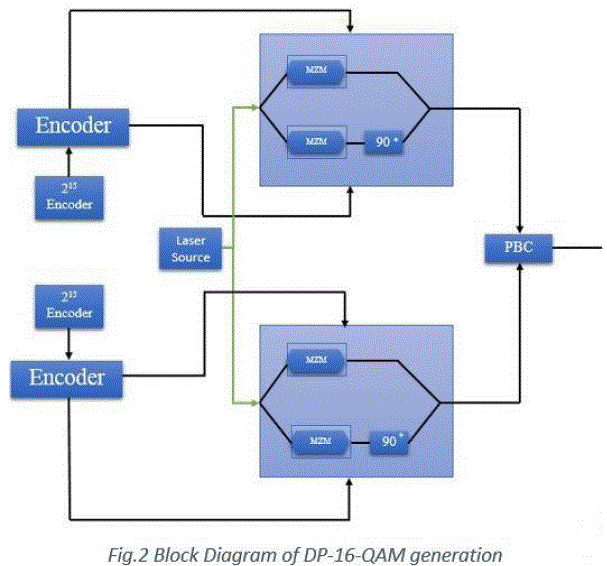 |
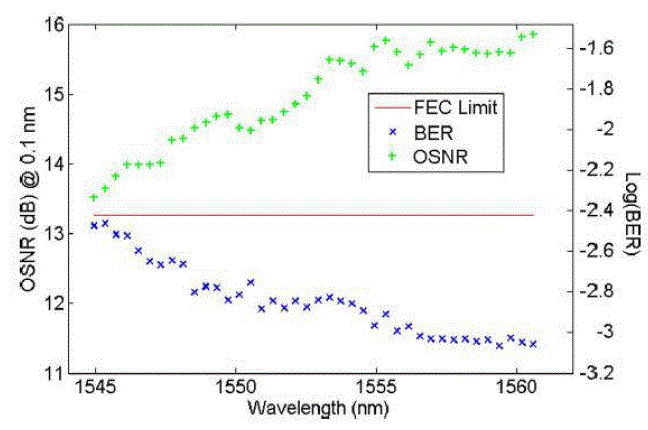 |
| Figure 1 |
Figure 2 |
Figure 3 |
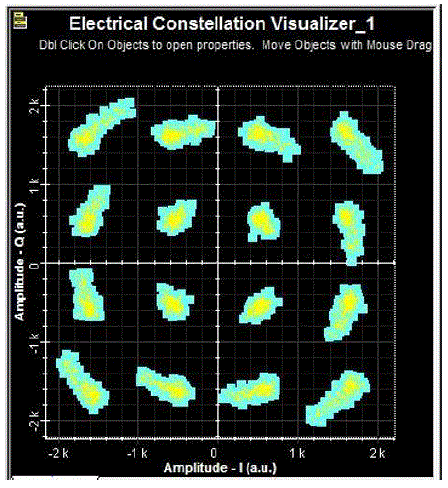 |
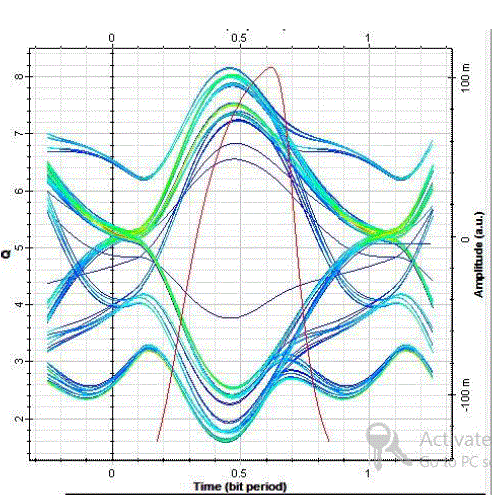 |
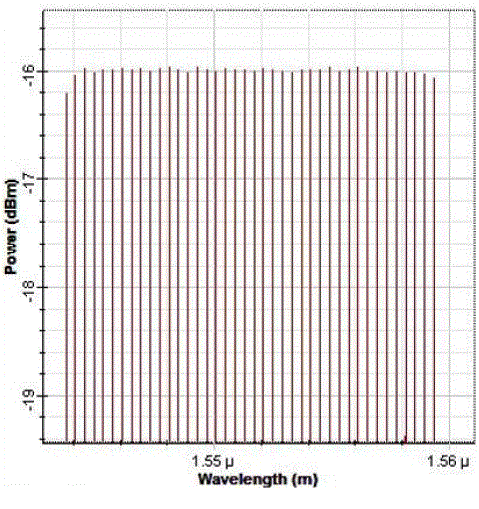 |
| Figure 4 |
Figure 5 |
Figure 6 |
|
| |
References |
- M. Du et al., ?Unrepeatered transmission of 107 Gb/s RZ-DQPSK over 300 km NZDSF with bi-directional Raman amplification,? in Proc.OFC/NFOEC, San Diego, CA, USA, Paper JThA47, 2008.
- D. Hardy et al., ?Optics, the key to the ultra high speed networks,? in Networks: Internet, Telephony, Multimedia: Convergences and Complementarities, 1th ed. Paris, France: Springer, ch. 5, pp.125?180, 2002.
- S. Bhandareet al., ?Optical coherent receiver with a switchable electrical dispersion compensator for 10 Gb/sDPSK transmission up to 300 km of SSMF in metro optical networks,? J. Lightw. Technol.,vol. 28, no. 1, pp. 47?58, Jan. 2010.
- D. Chang et al., ?8x120 Gb/s unrepeatered transmission over 444 km (76.6 dB) using distributed Raman amplification and ROPA without discrete amplification,? Opt. Exp., vol. 19, no. 26, Dec. 2011.
- D. Mongardienet al., ?2.6 Tb/s (26 100 Gb/s) unrepeatered transmission over 401 km using PDM-QPSK with a coherent receiver,? in Proc. ECOC, Vienna, Austria, Paper 6.4.3., 2009.
- Do-ilchang, Realtime processed 12 Ã 120 Gbsunrepeatered transmission over 383.5 km PSC fiber and 342.7 km SMF without ROPA?, Photonics Conference (IPC) IEE, 856-857, 2012.
- H. Bissessuret al., ?4 100 Gb/s unrepeatered transmission over 462 km using coherent PDM-QPSK format and real-time processing,? in proc. ECOC, Geneva, Switzerland, Paper Tu.3.B.3, 2011.
- Imdadul and SiddiqueHossain.?Comparison of traffic performance of QPSK and 16-QAM modulation techniques for DPsystem?, Journal of Telecommunication and Information Technology, 147-152, 2005.
|